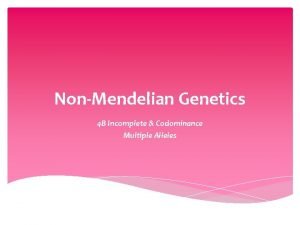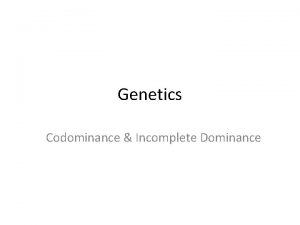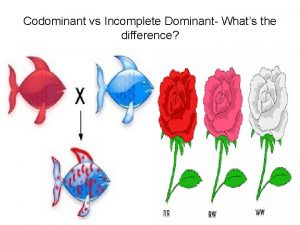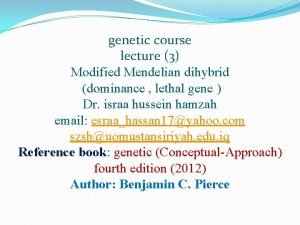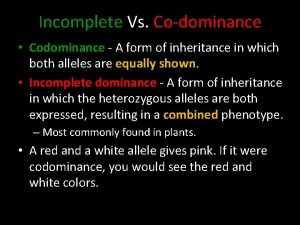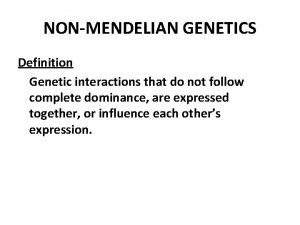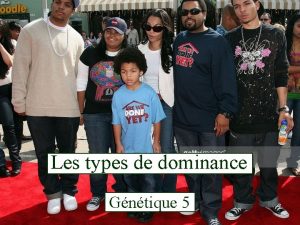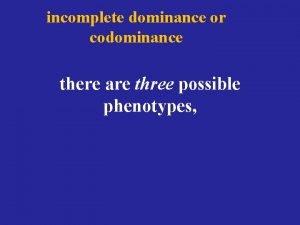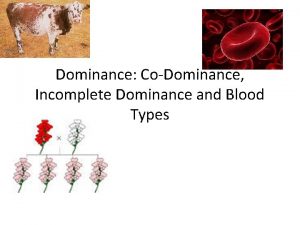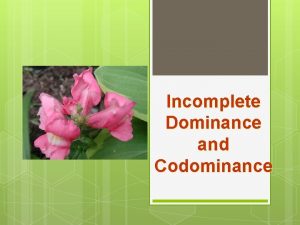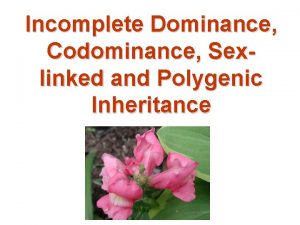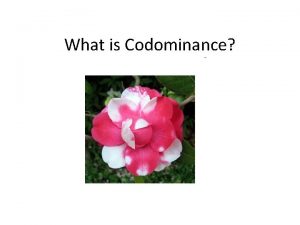Codominance and Incomplete Dominance Types of Dominance What

















- Slides: 17

Codominance and Incomplete Dominance

Types of Dominance What you have been taught so far is a very simplified version of how genes interact. It is often more complicated than just one gene being completely dominant over another. Today we will learn what it means for alleles to co-dominant and for alleles to show incomplete dominance. Co-Dominance Incomplete Dominance

Co-Dominance When alleles are co-dominant, it means that both alleles are always expressed. The phenotype will be a combination of both alleles. Blood types are a great example of co-dominance.

Red blood cell Your blood type results from a protein found in the membrane of your red blood cells. If you have the allele IA, then your red blood cells make a protein called antigen A. If you have allele IB, they make the protein antigen B. If you have gene i, then your red blood cells do NOT make either protein.

Red blood cell But if you have both alleles IA and IB, then you make BOTH proteins. These alleles are co-dominant because they are both always expressed!

IA IA i i IA IA i IB IAIB IBi IA IA i i 100% % A = _____ 0% % O = _____ IA i ii IA IA IA IB IAIB IBi IB IA IB IB IAIB IBi 50% % A = _____ 25% 0% % B = _____ 25% % O = _____ % AB = _____ 50% % AB = _____ 25% % A = _____ 0% % B = _____ 50% 0% % O = _____ % AB = _____ 50%


Incomplete Dominance Incomplete dominance occurs when a combination of alleles produces an intermediate trait. One trait is not completely dominant, so the phenotype of the heterozygote is between the dominant and recessive phenotypes.

Incomplete Dominance is easiest to see and understand in terms of pigment proteins. Dominant alleles produce colorful pigments, and homozygous dominant organisms produce bright rich colors. Recessive alleles often produce little to no pigment at all, so homozygous recessive organism are very light in color.

Incomplete Dominance When an organism is a heterozygote, it produces half the pigment since it only has one allele making pigment protein. This results in a color that is lighter than a homozygous dominant organism but darker than a homozygous recessive organism. It is an intermediate phenotype.

Animals, like these horses, often exhibit incomplete dominance in the color of their hair or skin. This produces a range of shades from light to dark. Photo by David Blaikie

Dark Brown Palomino Cream D d D DD Dd dd

Dark Brown Palomino Cream d d D Dd Dd d dd dd

R R r Rr Rr Incomplete Dominance 1. A species of flowers exhibits incomplete dominance between the allele for red flowers (R) and the allele for white flowers (r). If a plant that is homozygous for red flowers is crossed with a plant that is homozygous for white flowers, what percentage of offspring will have pink flowers? 100% pink flowers KEY:

R Incomplete Dominance 2. A species of flowers exhibits incomplete dominance between the allele for red flowers (R) and the allele for white flowers (r). If two heterozygous, pink plants are crossed, what percentage of each color of flower will appear in the offspring? 25% red flowers 50% pink flowers 25% white flowers r R RR Rr r rr KEY: Rr

Complete the following Punnett squares and answer the questions go with each cross. Subject A Subject B Subject C RR Rr rr Red Pink White Genotype for Flower Color Phenotype for Flower Color r r R r R Rr Rr R RR Rr rr R RR RR r rr rr r Rr Rr 50% 3 50% ½

Two different types of chickens are shown below. Assume each the chicken below is the result of a cross between a parent with black feathers and a parent with white feathers. Which breed seems to show co-dominance for feather color and which seems to show incomplete dominance. Chicken with Gray Feathers Incomplete Dominance An intermediate trait appears in the offspring. Chicken with Black & White Feathers Codominance Both traits appear in the offspring.
 What does incomplete dominance mean
What does incomplete dominance mean Codominance punnett square
Codominance punnett square Incomplete dominance definition
Incomplete dominance definition Whats co dominance
Whats co dominance The difference between dominance and codominance
The difference between dominance and codominance What is incomplete dominance
What is incomplete dominance Sickle cell anaemia
Sickle cell anaemia Phenotypic and genotypic ratio of dihybrid cross
Phenotypic and genotypic ratio of dihybrid cross Difference between complete and incomplete dominance
Difference between complete and incomplete dominance Incomplete dominance traits
Incomplete dominance traits What is incomplete dominance simple definition
What is incomplete dominance simple definition Incomplete dominance punnett square
Incomplete dominance punnett square Incomplete dominance dog
Incomplete dominance dog What is incomplete dominance
What is incomplete dominance When neither allele is dominant
When neither allele is dominant Incomplete dominance definition
Incomplete dominance definition Incomplete dominance punnett square
Incomplete dominance punnett square Dominant hair color
Dominant hair color
